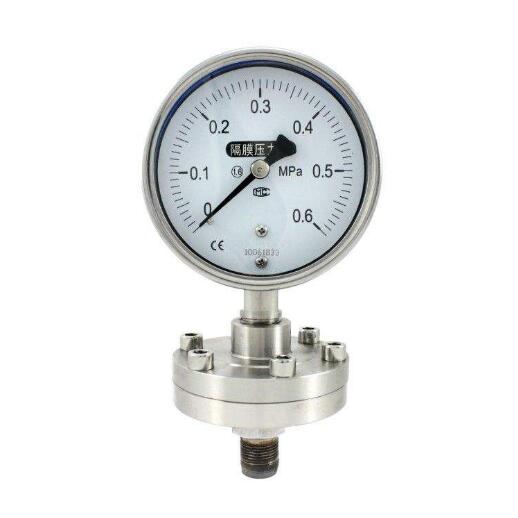Diaphragm pressure gauge
- Tel:0550-7591188
- Fax:0550-7591188
- Email:2136705934@qq.com
Description
Diaphragm pressure gauges can be used to measure the pressure of medium with strong corrosion, high temperature, high viscosity, easy crystallization, easy solidification, and solid floatation, and it is necessary to avoid the direct entry of the measuring medium into the general-purpose pressure instrument, to prevent the accumulation of sediments and to be easy to clean. A diaphragm gauge consisting of a diaphragm isolator and a general-purpose pressure gauge should be used.
Diaphragm pressure gauges are mainly used to measure the pressure of fluid media in the production process of petrochemical, alkali production, chemical fiber, dyeing, pharmaceutical, food and refrigeration industries. Structural principle When the pressure P of the measuring medium acts on the diaphragm, the diaphragm is deformed, and the sealing liquid of the pressure measuring system of the pressure instrument is compressed to form a pressure of P-△P. When the rigidity of the diaphragm is small enough, the ΔP is also very small, and the pressure formed by the pressure measuring system of the pressure instrument is close to the pressure of the measuring medium.
Second, the main technical indicators of the diaphragm pressure gauge
Temperature characteristics
Since the diaphragm pressure gauge system is filled with sealing liquid as the medium for transmitting pressure, due to the temperature expansion coefficient of the sealing liquid, the indication value of the pressure gauge increases with the increase of the temperature of the pressure-receiving part, and its temperature influence is related to the sealing liquid. The expansion coefficient, diaphragm stiffness and temperature of the pressure-receiving part are related, especially for low-range pressure instruments, the effect is more obvious. Generally, the temperature error of the pressure-receiving part is not more than 0.1%/℃. Therefore, the total temperature influence of the diaphragm pressure instrument is generally the sum of the temperature influence of the general-purpose instrument and the temperature influence of the pressure-receiving part of the diaphragm device. .
1: Accuracy class 1.5
2: Measuring range (Mpa) 0~0.1 0~0.16 0~0.25 0~0.4 0~0.6 (special specifications please specify when ordering)
3: Diaphragm material PTFE polytetrafluoroethylene sheet
4: Internal filling of working fluid (1) Silicone oil (2) Filling according to customer needs
5: Working conditions
(1) Temperature Ambient temperature - 20~+[1] 55℃ Measured medium temperature - 20~+55℃
(2) Static load of working pressure: use up to 3/4 of the upper limit of measurement
Alternating load: use up to 2/3 of the upper limit of measurement
Short-time pressure: use up to the upper limit of measurement
6: Connection size (1) Threaded connection: M20*1.5 (G3/8″ G1/2″)
(2) Flange connection A: Ministry of Machinery Industry Standard JB81-5 "Flat Welded Steel Flange"
B: Standard of the Ministry of Chemical Industry "Acid Resistant Flat Welded Steel Flange"
C: Our company flange standard
D: Customized according to user needs
7: Knowledge meter outer diameter (φ75mm) φ100mm
8: Model and form Product model connection form range of use
YTP-75S threaded connection is used to measure the pressure of strong corrosive media. Such as: chlorine, hydrochloric acid, nitric acid, etc.
YTP-100S thread connection is the same as above
YTP-75SF flange connection is used for the pressure of the medium with strong corrosiveness, high viscosity and easy crystallization.
YTP-100SF flange connection is the same as above




